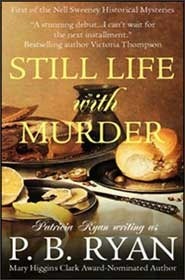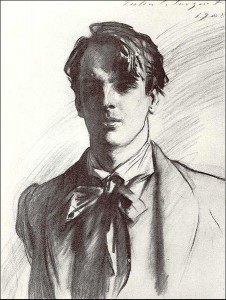Flawed heroes – part five
(and the others in the Nell Sweeney Mysteries)
by P.B. Ryan
 No character that I've ever written has generated as much fascination among my readers as the highly flawed, deadly handsome, dangerously charming Will Hewitt. Will is my governess-sleuth's partner in detection—and love interest, although they dare not speak of it—in the Nell Sweeney historical mysteries, set in post-Civil War Boston.
No character that I've ever written has generated as much fascination among my readers as the highly flawed, deadly handsome, dangerously charming Will Hewitt. Will is my governess-sleuth's partner in detection—and love interest, although they dare not speak of it—in the Nell Sweeney historical mysteries, set in post-Civil War Boston.
The black sheep son of Nell's wealthy employer, Dr. William Hewitt was regarded as the finest battle surgeon in the Union Army before his capture and incarceration at the notorious Andersonville prison camp, where he was reported to have succumbed to dysentery. Four years later, his family is stunned when he turns up alive and accused of a vicious murder he won't deny having committed. Plagued by survivor guilt and the pain of an old bullet wound in his leg, Will roams the world frequenting high-stakes poker games and back-room opium dens, where he seeks blessed oblivion in the arms of Morphia.
When we meet him in book #1 of the series, Still Life With Murder, Will is deeply damaged inside and out, an addict who walks with a limp and doesn't care whether he lives or dies. Bloodied from a police interrogation and in the grips of opium withdrawal, he frightens and disgusts Nell—yet she can't help but be intrigued by his touching protectiveness toward women and his occasional courtesies, which "hint at the gentleman beneath the wretch."
Despite Will's shortcomings, I found him totally captivating, but I thought, well, maybe that's just me. Maybe there's something twisted in my psyche that makes flawed men appealing to me. So imagine my surprise when, following Still Life's publication by Berkley Prime Crime in 2003, I was inundated with mail from readers who were just as in love with him as I was. What, I wondered, would make such a seemingly hopeless piece of work attractive to normal, well-adjusted women?
Will's flaws are both physical and psychological. Let's start off with the physical: the injured leg. Wounded heroes are nothing new in literature, and I recently discussed their appeal with the noted literary historian Susan Koppelman (who, I'm pleased to report, will be delivering a presentation about the Nell Sweeney mysteries at the upcoming national conference of the Popular Culture Association). If the male is historically considered the dominant partner in a heterosexual relationship—as was certainly the case in pre-20th century settings—then an injury would serve to diminish his physical supremacy, putting him on a more equal standing with the heroine.
 Susan tells me this is considered a metaphorical "gelding" of the hero, and that the symbolism is especially pointed when it's the leg—thought to represent the phallus—that has suffered the injury. Gee, maybe I really am twisted, I thought, since there are three other male protagonists besides Will who've limped their way through my books. Maybe I'm subconsciously castrating my heroes. Or maybe a cigar is just a cigar. After all, not all of my wounded heroes had leg injuries. Or so I reassured myself until Susan laughingly reminded me of my medieval romance The Sun and the Moon, in which the hero is a mercenary knight who had a thumb chopped off, after which he couldn't wield his sword.
Susan tells me this is considered a metaphorical "gelding" of the hero, and that the symbolism is especially pointed when it's the leg—thought to represent the phallus—that has suffered the injury. Gee, maybe I really am twisted, I thought, since there are three other male protagonists besides Will who've limped their way through my books. Maybe I'm subconsciously castrating my heroes. Or maybe a cigar is just a cigar. After all, not all of my wounded heroes had leg injuries. Or so I reassured myself until Susan laughingly reminded me of my medieval romance The Sun and the Moon, in which the hero is a mercenary knight who had a thumb chopped off, after which he couldn't wield his sword.
Thumb. Sword. Oh, dear.
On the other hand… is a little bit of gelding necessarily such a bad thing? Bear with me here. There's been speculation among those who study such things that the irritability, hostility, and mood swings that women sometimes experience during PMS are what men experience pretty much all the time. Which, if true, would make women the more emotionally stable and, dare I say it, civilized sex. By chipping away at the hero's most prominent masculine characteristic—his physical dominance—could it be that we're not symbolically lowering him to the heroine's level, but elevating him to it?
The classic hero is strong of mind as well as of body, and more often than not somewhat self-contained. We've been brought up to feel that real men don't bare their souls. But if the heroine can't penetrate the armor the hero wears around his soul, how can she really know him, much less love him? The answer: create a flaw in the armor, an opening your heroine—and reader—can see into. As Susan Koppelman puts it, "If you think of the hero as a closed container, the only way to know what's inside it is to wound it."
Which brings us to William Hewitt's drug addiction. Judging by hundreds of letters from smitten readers, Will's dependence on opiates does nothing to diminish his appeal; in fact, it may amp it up. I think this is because a psychological flaw, like a physical flaw, can serve in some cases to level the playing field of the relationship. The hero may pretend to be emotionally invulnerable, but we know better.
With a hero whose problems are mental rather than physical, I think it's important to at least hint that he's not completely irredeemable; there's a reason he is the way he is, and there's also the potential for recovery. In Will's case, he started smoking opium to numb the physical pain of his bullet wound, but he persisted in it to deaden memories he couldn't escape any other way—memories in which his courage and valor failed to prevent his brother's tragic death. Will's emotional vulnerability, which he conceals beneath a droll and world-weary façade, tugs at the heart, arousing an instinctive urge to take away the pain that haunts him.
And that brings us to the bottom line: The flawed hero is almost always a fixer-upper. During the course of the story, the heroine often manages to vanquish whatever demons were tormenting him, or even heal his physical wounds, thus restoring the trappings of full manhood—and making him capable of a real relationship. In real life, men who need fixing tend to be Bad News; there are few pursuits as futile as trying to change or improve a loved one. But that's exactly why such a transformation is so thrilling when a fictional female manages to pull it off. By making the hero a better man, physically and/or emotionally, our heroine triumphs—and the reader closes the book with a smile on her face.
About P.B. Ryan
P.B. Ryan(the artist formerly known as Patricia Ryan) is the award-winning author of 27 novels and novellas, which have been published in over 20 countries, including Serbia. That's right, Serbia.
Pat tapped into her fascination with 19th century urban America to create the Nell Sweeney mysteries for Berkley Prime Crime. Set in post-Civil War Boston, the series stars Nell, a young Irish-born governess with a disreputable past that must be kept hidden at all costs. Nell is assisted in her sleuthing by her employer's black sheep son, William Hewitt. A former Union Army battle surgeon, Will is now a professional gambler who smokes opium to dull the pain of his wounds, both inside and out. The reaction of the series' fans to the complicated, slowly evolving relationship between Nell and Will ("the beating heart of the series" as one reader put it) delights Pat, who is deeply wrapped up in them herself. The series has been as popular with critics as with readers, and Murder in a Mill Town was chosen as a finalist for the Mary Higgins Clark Award.
Upon getting the rights back to the six Nell Sweeney books (as well as to six novels of medieval romantic suspense written for NAL), Pat published them in digital format. The first book of the series, Still Life With Murder, has made it to the #1 spot on Amazon's historical mystery bestseller list. In 2010, Pat and fellow author Doranna Durgin launched backlistebooks.com, a showcase of author-published out-of-print ebooks. Once upon a time, Pat worked in the publishing industry as a promotion manager and editor, but she quit her job when she was offered her first publishing contract in 1994, and she's been spending her days making stuff up ever since.
Visit P.B. Ryan's website to learn more about her and her work. Her work is available at Amazon and online wherever books are sold. I'm proud to have met Ms. Ryan through Historical Fiction eBooks, where Historical Fiction of the highest quality is brought together in one source. Check them out! You can also follow Ms. Ryan on Twitter and Facebook.



